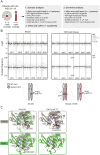Genetic Insights Into Hypothalamic Hamartoma: Unraveling Somatic Variants
- PMID: 39246740
- PMCID: PMC11380500
- DOI: 10.1212/NXG.0000000000200180
Genetic Insights Into Hypothalamic Hamartoma: Unraveling Somatic Variants
Abstract
Objectives: Hypothalamic hamartomas (HHs) are rare developmental brain lesions associated with drug-resistant epilepsy and often subjected to epilepsy surgery. Brain somatic variants in genes affecting the Sonic hedgehog (Shh) and primary cilia signaling pathways have been implicated in approximately 50% of nonsyndromic HH cases. This study aims to characterize a new cohort of 9 HH cases and elucidate their genetic etiology.
Methods: We recruited 9 HH cases including 8 nonsyndromic cases of which 4 were type IV HH. Genomic DNA was extracted from peripheral blood and surgical brain tissues, and somatic variants were investigated using high-depth whole-exome sequencing.
Results: Pathogenic somatic variants in known HH genes (GLI3, OFD1, and PRKACA) were identified in 7 of the 9 cases. In addition, a 2-hit mutational event comprising a germline variant (predicted to impair kinase activity) and a somatic loss-of-heterozygosity was identified in TNK2, a gene encoding a brain-expressed tyrosine kinase.
Discussion: Our findings reinforce the role of somatic variants in Shh and cilia genes in HH cases while also shedding light on TNK2 as a potential novel disease-causing gene. This study emphasizes the increasing importance of brain mosaicism in epilepsy disorders and underscores the critical role of genetic diagnosis derived from resected brain tissue.
Copyright © 2024 The Author(s). Published by Wolters Kluwer Health, Inc. on behalf of the American Academy of Neurology.
Conflict of interest statement
The authors report no relevant disclosures. Go to Neurology.org/NG for full disclosures.
Figures


References
-
- Accessed January 22, 2024. swissmodel.expasy.org/
LinkOut - more resources
Full Text Sources
Research Materials
Miscellaneous
